Our customers handle more data, more complex data, and across more channels every day. This calls for robust technological support. By viewing the PIM system as critical infrastructure, you can increase your ROI.
We rarely encounter companies that don’t feel pressured by increasing complexity when the conversation turns to e-commerce and online trading. There are more products, more variants, and more markets and channels to support—while quality, of course, remains a crucial factor.
Naturally, many therefore look for answers in the world of technology, which often promises solutions to our digital challenges.
However, most technologies don’t achieve much on their own.
If an IT system isn’t supported by the necessary budget, good processes, and a focus on standardization, companies often end up with a cumbersome solution and a significant amount of technical debt.
Our experience also tells us that the way companies articulate and prioritize the criticality of their various systems is tremendously important for a system’s potential to become a valuable asset. The right prioritization creates clarity and makes it easier to allocate the appropriate resources—or the right amount of resources—to the system’s development and operation.
In this post, we describe how companies that treat their PIM system as critical infrastructure experience a higher ROI on their PIM investment compared to companies that don’t embrace their solution to the same extent.
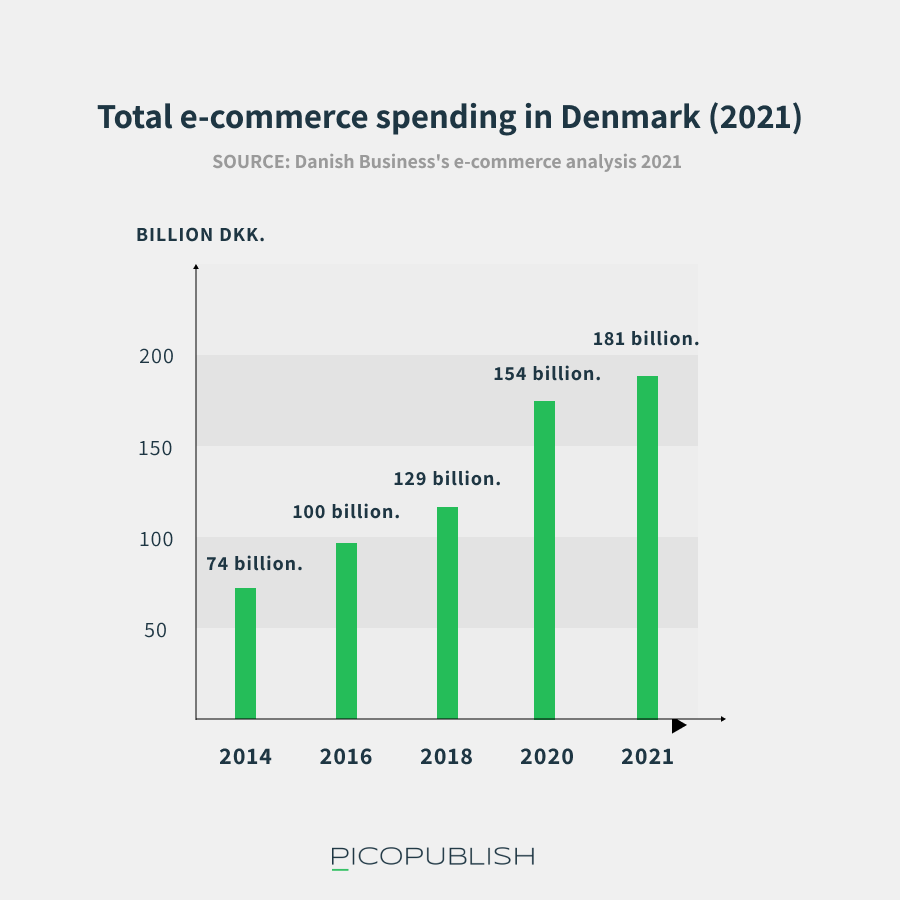
Why talk about "complexity" and "criticality"?
E-commerce, both within and beyond Denmark’s borders, has been on the rise over the past 10 years. The latest e-commerce analysis from Dansk Erhverv shows that we continue to spend more money shopping online (although many might perceive 2022 as a tough e-commerce year).
Looking at the major Danish e-commerce players, we can also see year after year that functionality, product offerings, and the overall shopping experience are rapidly evolving—often for the better. Competition is increasing, and the demands on new market entrants are growing.
Today, it’s not enough to launch a half-hearted e-commerce concept if you want to succeed in selling your products online.
As a seller, you need to have the right products, the right prices, and be present in the right channels/markets (the latest addition being, of course, Chinese TikTok, which is experiencing significant global growth).
The complexity of architecture, design, and the overall user experience is constantly increasing.
As a result, many companies are naturally looking for one or more technologies to help manage this complexity in their pursuit of delivering the best possible shopping experience for their customers.
Want to talk data?
If you’re interested in hearing our ideas on how data can help your business execute, grow, and scale, we’re ready for a no-obligation conversation.
The promise of using Product Information Management - Gain clarity and take control of the processes surrounding your product data
One of the technologies experiencing increased interest in recent years is PIM systems.
Although Product Information Management (PIM) and PIM systems are not a new invention, it is only in recent years that PIM systems have become mainstream in e-commerce contexts.
As companies increasingly need to handle more and more data, the necessity of PIM only grows, which has naturally sparked a wave of PIM investments. We feel this particularly strongly here at PicoPublish, where our contacts who previously opted out of or underprioritized PIM are now shifting gears and focusing on this very part of their business.
The rise of PIM systems makes perfect sense when you consider their primary common feature:
- A PIM solution is a central system for managing and publishing product data.
The challenges associated with using outdated webshop technologies or CMS platforms to manage—and, not least, distribute—product data are catching up with large companies that operate with thousands of different products and variants.
A good PIM system, therefore, always comes with the promise of making it easy to:
- Create products
- Enrich them with data (possibly from other systems)
- Categorize and prepare this data for distribution
- And, most importantly, publish products in the right channels (webshops, marketplaces like Amazon, apps, catalogs, social media, and much more).
There is hardly any doubt that PIM systems address the challenges brought about by increased complexity and competition.
But how do you know IF and HOW MUCH you should invest in your PIM system?
Disclaimer: Not all companies need PIM
Let’s make it absolutely clear: A PIM system is not automatically a good investment for all companies working with e-commerce.
If you have fewer than 1,000 products/combinations/variants in your catalog, or if you only need to support a single language layer, a PIM system typically cannot deliver scalable results (e.g., in the form of streamlined workflows).
On the other hand, the ROI on a PIM investment is significant for companies with large product catalogs, those supporting multiple markets, or those dealing with complex products with hundreds of variants.
PIM is a particularly good investment if you actually invest in more than just a license for your preferred system.
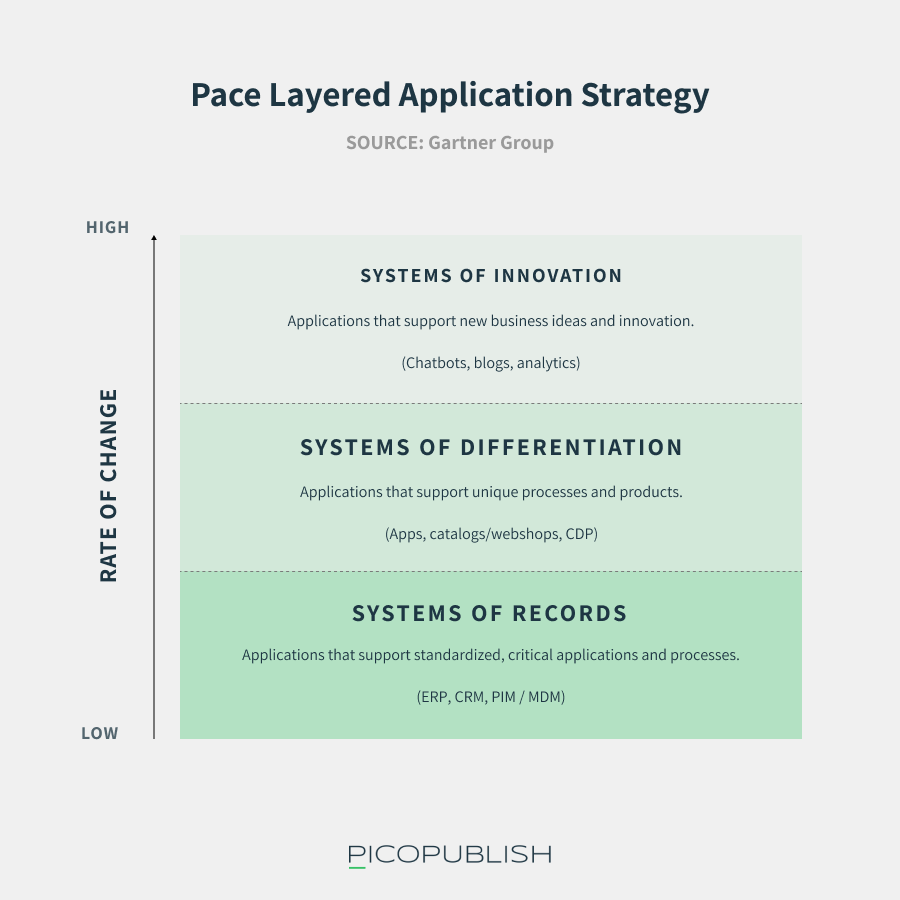
What does it mean for something to be "critical IT infrastructure"?
The American analysis firm Gartner, Inc. is among the most influential in the field of technology analysis, digital innovation, and IT strategy.
Whether one agrees with their bold forecasts or not, it must be acknowledged that their methods and tools often become embedded in the industry’s terminology.
One of the strategic tools Gartner has successfully introduced is their “Pace-layered Application Strategy”.
This framework can, among other things, be used to map systems/components in a company’s IT infrastructure, with the aim of developing appropriate governance models for each individual system (or system group).
The more critical a system is to the company, the more focus there should be on developing policies and processes that support users’ daily interaction with the system. This is particularly relevant for a system that is a central component in the production of the company’s core focus - its products.
ERP and CRM — and now PIM — as Systems of Record
Let’s take a closer look at the layers in Gartner’s model to better understand the arguments for placing PIM in the most critical layer — Systems of Record.
At one end of Gartner’s model, we find Systems of Innovation - these are typically smaller systems, integrations, and features that are categorized as niche services (such as chatbots). Systems in this category can often be replaced quickly and generally do not require strict governance or lifecycle management.
Larger enterprises typically do not allocate a significant portion of their budget to developing and maintaining these systems.
At the opposite end of the spectrum are Systems of Record. These are the critical IT systems that form the backbone of an organization’s daily operations (e.g., financial data, customer data, industry-specific master data, or product data). ERP and CRM systems are commonly found in this category.
Systems of Record rarely change their fundamental character. They usually store master data (or "raw" data), which is then shared with applications that process and present the data in new, value-adding ways (e.g., analytics, advertising platforms, etc.).
Both ERP and CRM systems have long been considered mission-critical for any digital business — and rightfully so. Without ERP and CRM, a company will struggle to:
- A) support internal business and production processes, and
B) support the sales and communication of its products and services.
These two types of systems have become well-established across industries and are widely recognized as essential tools for enabling modern commerce and operations.
So why should PIM systems also be categorized as "critical infrastructure"?
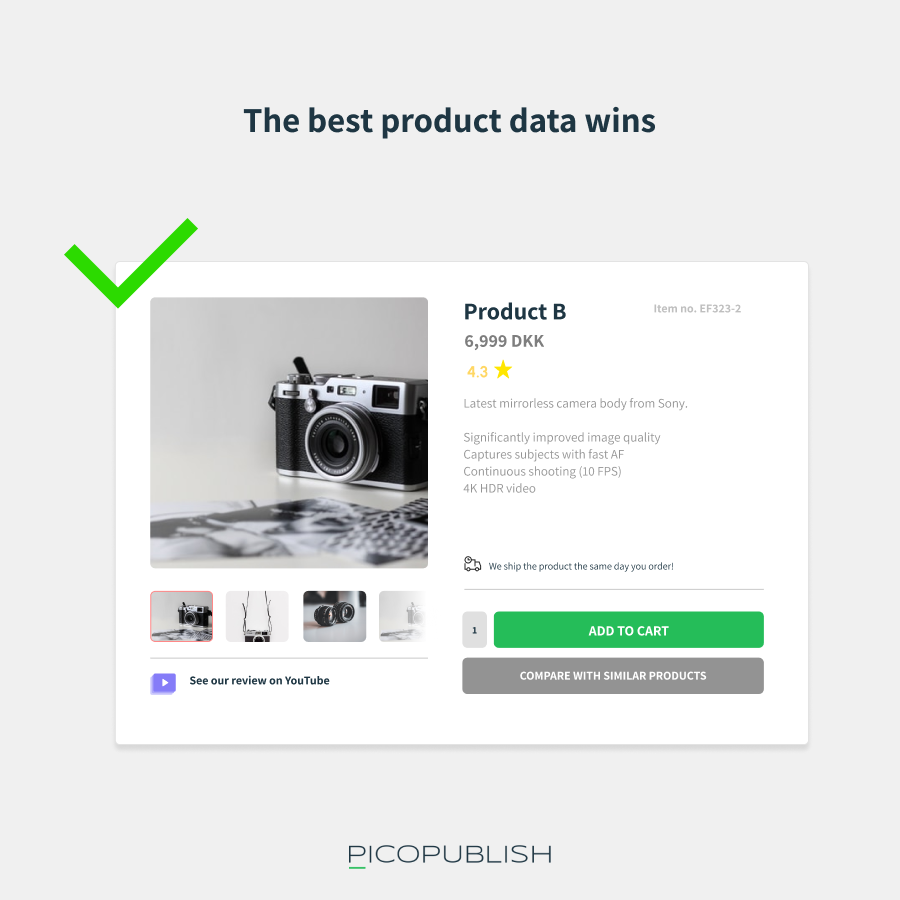
The company with the best product data wins the customer
When we argue that a PIM system today is critical infrastructure for ambitious e-commerce companies, it’s simply because the company with the best product data wins the customer.
It really is almost that simple.
Imagine trying to sell your products in different countries without having localized prices and descriptions attached to your products.
Now imagine that your competitor has twice as many images* of the same products you’re selling.
Or that their product descriptions are longer and more detailed.
Or that they offer 3D views of their products.
Or easy access to downloads like manuals and product sheets.
And the list goes on...
Now picture that your competitor is present on the platforms where your customers are.
That could be Instagram Shopping, Amazon, Elgiganten (yes – they have a marketplace too), or your industry's central marketplace platform.
- Who wins the customer? It’s the company with the best product data and the ability to be present in the right channels.
The justification for PIM systems in 2022 lies precisely in their ability to help companies with many complex products and variants overcome the challenges of an increasingly complex market.
*Quantity isn’t the most important metric – but it’s still a factor. Especially when it comes to technical specifications, having more data and measurement points can be a key differentiator – and thus a competitive advantage.
Systems of Record - ”What gets measured, gets managed”
As the classic Peter Drucker quote goes: “What gets measured gets managed.”
In Gartner’s Pace Layered Strategy framework, Systems of Record are characterized by a strong need for governance — meaning well-defined processes and control.
This is a natural consequence of the fact that systems labeled as “critical” must contain accurate and reliable data, as they are essential to the core processes of the business.
That’s also why the majority of an organization’s IT resources typically go toward maintaining and optimizing this system layer.
Gartner describes these systems and their data as follows:
- ”Given the highly structured and often regulated nature of systems of record, the process and data integrity requirements are very high and well-understood. In moving up the layers, organizations need to embrace the fact that processes will be less controlled and more flexible, and that the nature of data quality will change.”
PIM is Critical Infrastructure for Any Ambitious E-Commerce Player
A PIM system is the technological manifestation of Product Information Management as a discipline.
PIM is also frequently categorized under MDM (Master Data Management), and both disciplines cover a range of domains, techniques, processes, and methods — all designed to strengthen the business by developing the necessary, correct, and most efficient protocols for managing data.
A PIM system should therefore be placed in a context where it’s viewed as a necessary part of the overall IT infrastructure — otherwise, you lose the ability to present the right data, in the right context.
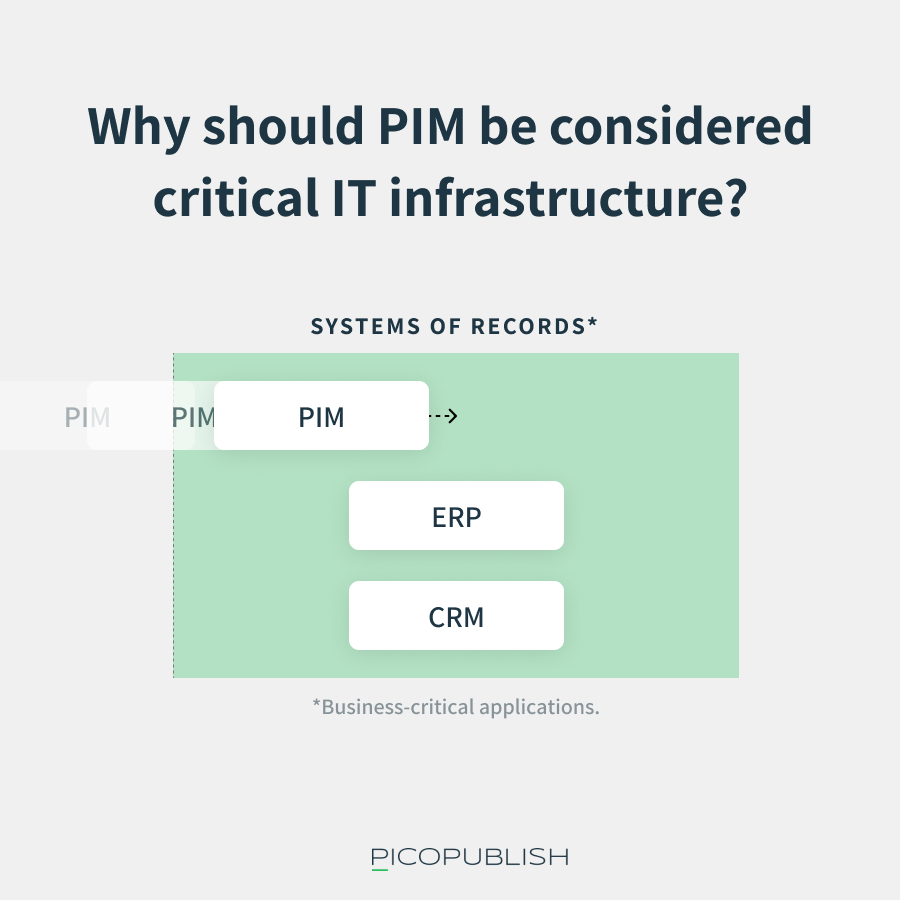
How solid processes ensure the best product data
If you want to win the customer's favor, the customer must be met with ACCURATE data, SUFFICIENT data, and this across ALL your products and ALL your channels.
This is precisely why good processes are a crucial part of the success you will experience with your ecommerce efforts.
And this is where Product Information Management (PIM) and the PIM system naturally come into play.
ERP systems are not built to handle product data (media files, language layers, integrations to e.g., webshops). Therefore, it becomes both expensive and risky to force the business-critical ERP system to be the primary source of product data.
Unlike ERP systems, PIM systems are specifically designed to make the processes around collecting, enriching, planning, and publishing data easier.
This is partly because PIM systems (such as inriver or Perfion) make it easy to support the processes that ultimately allow the customer to access and purchase a product.
These processes might include:
Data collection:
- Integration with ERP
- Integration with local databases
- Integration with supplier databases
Enrichment:
- Setting up roles and permissions in the PIM system
- Quality assurance of data (e.g., alerts for missing data)
- Planning and building channels
- Notifications and alerts
- Tagging, sorting, and hierarchical categorization of products
Data publishing:
- Integration with catalog engines (e.g., InDesign/EasyCatalog)
- Integration with Amazon
- Integration with webshop
- Automatic publishing/updating of new products (that meet the quality requirements defined during enrichment)
The more you work with your data, the better you become at building the processes that are right for your company and your employees.
The reason the PIM system should be regarded as critical IT infrastructure is that, as system owners, you are compelled to work on defining the policies and processes that make the PIM system a valuable asset rather than a potential risk.
The Risk of Placing Systems in the Wrong Strategic Layers
In some cases, we see companies invest in PIM only to use the system as a glorified image bank. This can work in certain situations (although a full-fledged DAM solution would be better suited for that purpose).
However, more often than not, we find that these companies get the worst of both worlds: “yet another system” to maintain, with no focus on leveraging the system’s strengths.
“You reap what you sow.”
If the PIM system is implemented half-heartedly, you rarely get the full benefit of your investment.
For example, a PIM system won’t automatically help you identify your weakest processes unless the system is made a central part of your IT infrastructure. As mentioned: systems that aren’t treated as critical to business success don’t get the necessary attention. And as an ecommerce player—what could be more important than the products you sell?
Put another way: if the ERP system continues to own most of your product data, you will never benefit from the PIM discipline (better data governance, fewer errors, improved support for cross-functional collaboration, supplier support, etc.).
Most likely, you’ll end up paying for yet another license and for developing integrations that you neither use nor maintain.
If your company chooses to ignore the PIM system and store product data in other systems—how will you ever enforce the policies and processes that were carefully designed when implementing the PIM solution?
In other words, a PIM system delivers value when it functions as the “Single Source of Truth” for your product data.
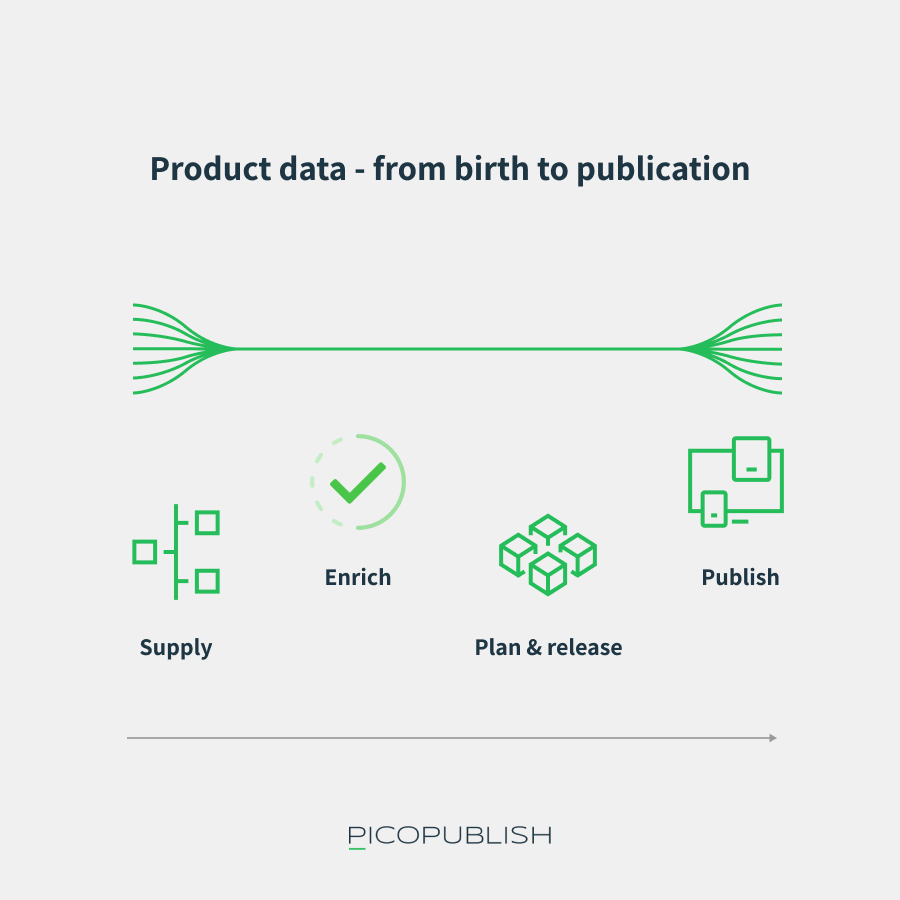
Drucker was right…
“What gets measured, gets managed” – and it turns out that this is actually quite true.
An investment in Product Information Management and a PIM system is not only an investment in technology, but also in the organization and processes that support the use of that technology.
In a reality with increasing competition on digital platforms, it is essential that you can work efficiently with your product data if you want to be able to present your customers with consistently high quality when they encounter your brand and products across platforms.
If you treat your PIM system with the attention a data management solution for your highly valuable product data SHOULD receive in 2022, most will also find that the PIM system ultimately helps you meet the customer’s expectations for a great shopping experience. You will notice this as the PIM system helps you in the following ways:
- Easier product creation
- Easier onboarding of data sources and data
- Smart enrichment of product data with support for roles, notifications, and automated quality controls
- Flexible management of categories and feeds to external systems (webshops, marketplaces, apps, catalogs, etc.)
- Easy publishing of products and data to the right platforms.


